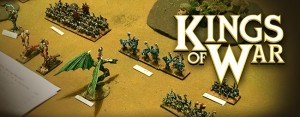
Every once in a while, our gaming group takes a break from “serious” historical gaming to indulge in something else, usually both whimsical and fun.
Last night was such an event with John Desch pulling out his old 10mm Warmaster Fantasy figures so the group could try out Kings of War by Mantic Games. Both John and Joe Moore had gotten heavily into Warmaster and so have tons of painted figures for the various races gathering dust. So, much like the group has done by using our existing 6mm collections to game Arab Isreali Wars and Team Yankee, the existing collection is getting repurposed for this, at least in the short term.
Since Games Workshop decided to completely “reboot” Warhammer Fantasy with the release of Age of Sigmar, many Warhammer Fantasy players have been looking for a rules set to use with their existing models and, at least locally, Kings of War seems to be the consensus choice. I am not a Warhammer Fantasy player (although I did buy the 7th edition starter box long ago), so I don’t really have a frame of reference to compare the two games. However, I will say that Kings of War seems more accessible and fun to a non-initiated historical player than Warhammer Fantasy seemed to be. The rules and 70% of each army list are free to download, with the remainder of the army lists located in the rule book. Both the printed rulebook ($40 MSRP) and the figures Mantic sells for the game seem much closer to the price of historical gaming figures than to the sky high prices that Games Workshop charges for its games, so it also passes my “Would playing this bankrupt me?” test.
So with all that said, how does it play? While I can’t vouch for tournament or competitive play, we all had a blast with it! There was lots of laughter and there was no way (for us at least) to make it too serious. The game is a basic IGO-UGO with a move/shoot/melee sequence of play. The game does have some unique features though. The phasing player rolls the dice for everything in their player turn (to include nerve(morale) tests)and only the defending players units take damage. The basic attack sequence is to roll a number of dice per unit attacking to generate a number of successful attacks. Each successful attack is then checked to see if it penetrated the enemy defense to inflict damage. A cumulative number of damage points are then marked on the enemy unit. For any unit damaged, two dice are rolled and added to the cumulative damage on the unit to conduct a “Nerve Test”. This can result in either no effect, a hesitating unit (no attacking or moving towards the enemy in their turn) or a having the unit rout off the board. However, until a unit fails a Nerve Test to rout, they fight on with no effect from the damage, allowing them to inflict damage to the enemy in their turn. Close by leaders can allow units to re-roll a nerve test, so leader placement makes a difference. Overall, this makes for a fast playing, fun and, at least for us, light hearted game. If you are worried about that unit that you spent hours painting getting blown off the table on first contact, this may not be the game for you, but since we are playing with figures that would otherwise be gathering dust….
I suspect that we will play again soon and that these will be our light hearted change of pace game for a while. We had fun with them and I suspect you will too, especially if you have painted fantasy figures sitting around looking for a rules set to use them with.
Rat 6 Out!